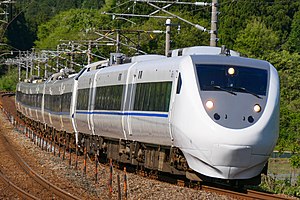

| 681 series | |
|---|---|

A JR-West 681 series train on a Thunderbird service in April 2022
| |
| Manufacturer | Niigata Transys, Kawasaki Heavy Industries, Kinki Sharyo, Hitachi |
| Constructed | 1992 (Prototype set) 1995–1997 |
| Entered service | 1992 |
| Refurbished | 2015–2018 |
| Scrapped | 2015– |
| Number built | 102 vehicles |
| Number in service | 99 vehicles (as of 1 October 2015[update])[1] |
| Number scrapped | 3 vehicles[1] |
| Formation | 3/6 cars per trainset |
| Operators | JR-West (1992–) Hokuetsu Express (1997–2015) |
| Depots | Kyoto, Kanazawa |
| Lines served | Tokaido Main Line, Kosei Line, Hokuriku Main Line, Nanao Line, Shinetsu Main Line, Joetsu Line, Hokuetsu Express Hokuhoku Line |
| Specifications | |
| Car body construction | Steel |
| Maximum speed | 160 km/h (100 mph) (Hokuhoku Line)[2] 130 km/h (80 mph) (JR lines) |
| Traction system | Thyristor drive + Variable frequency (GTO) |
| Acceleration | 1.8 km/h/s (1.2 mph/s)[3] |
| Deceleration | 5.5 km/h/s (3.4 mph/s)[citation needed] |
| Electric system(s) | 20 kV AC 60 Hz / 1,500 V DC overhead |
| Current collector(s) | WPS27C scissors-type pantograph |
| Braking system(s) | Regenerative brake, electronically controlled pneumatic brakes, snow-resistant brake |
| Safety system(s) | ATS-SW, ATS-P |
| Multiple working | 683 series |
| Track gauge | 1,067 mm (3 ft 6 in) |
The 681 series (681系, 681-kei) is a dual-voltage electric multiple unit (EMU) train type operated by West Japan Railway Company (JR-West) on limited express services in Japan.
Four six-car sets (T01–T03, T06) and five three-car sets (T11–T13, T15, T17) are used on Thunderbird services. These trains feature Thunderbird branding. Also four six-car sets (W01–W04) and four three-car sets (W11–W14) were used on Hakutaka services. These trains featured "White Wing" logos.[4]
From February 2015, Hakutaka W sets began being repainted into the same livery as 683 series trainsets used on Shirasagi services, with thin blue and orange lines below the window band.[5]
The pre-series six-car set (T18) and one three-car set (T07) are used on Thunderbird services.[4]
Two six-car sets (N01–N02) and two three-car sets (N11–N12) were formerly used on Hokuetsu Express Hakutaka services. These trains featured "Snow Rabbit Express" logos.[4]
All of the 681 series trainsets used on Thunderbird limited express services underwent a programme of refurbishment from autumn 2015 until the end of fiscal 2018.[6]
|
| |||||||||||||||||||||||||||||||||||
|---|---|---|---|---|---|---|---|---|---|---|---|---|---|---|---|---|---|---|---|---|---|---|---|---|---|---|---|---|---|---|---|---|---|---|---|
| Current / active |
| ||||||||||||||||||||||||||||||||||
| Retired / withdrawn |
| ||||||||||||||||||||||||||||||||||